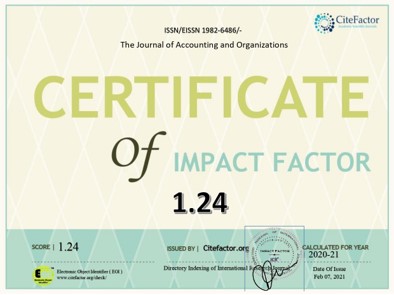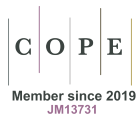Social network analysis against corruption: a study of the public budget related to the Covid-19 pandemic
DOI:
https://doi.org/10.11606/issn.1982-6486.rco.2022.191515Keywords:
Social network analysis, Graph, Corruption, PandemicAbstract
The fight against the Covid-19 pandemic triggered almost immediate reactions from governments worldwide. Economic resources were requested to maintain the economy and help families and businesses, causing unprecedented changes in public budgets. However, this context opened a window of opportunity for corruption, an evil that afflicts all societies. Against this backdrop, this study captured budget data and applied social network analysis and graph mining techniques to examine the 2020 Brazilian extraordinary federal budget related to Covid-19, searching for signs of corruption in municipalities. The results indicate the potential of the graph approach to identify municipalities more susceptible to corruption since studying the relationships between companies and municipalities offers investigative insights that would probably not be achieved through traditional models. The findings are a valuable source for scholars and practitioners looking for methods to improve the work of monitoring and control agencies and law enforcement.
Downloads
References
Amani, F. A., & Fadlalla, A. M. (2017). Data mining applications in accounting: A review of the literature and organizing framework. International Journal of Accounting Information Systems, 24, 32-58. https://doi.org/10.1016/j.accinf.2016.12.004
Amaral, L. S., Gomes, D. A., Oliveira, A. C. F. M., Oliveira, M. G. F. M., Nunes, J. E. O., Silva, M. M. L., Cordeiro, N. M., Santiago, E. J. P., Santos, A. L. P., & Moreira, G. R. (2020). Cluster analysis involving the world corruption perception index: An approach applied to South America. Research, Society and Development, 9(7). https://doi.org/10.33448/rsd-v9i7.4471
Anessi-Pessina, E., Barbera, C., Langella, C., Manes-Rossi, F., Sancino, A., Sicilia, M., & Steccolini, I. (2020). Reconsidering public budgeting after the Covid-19 outbreak: key lessons and future challenges. Journal of Public Budgeting, Accounting & Financial Management, 32(5), 957-965. https://doi.org/10.1108/JPBAFM-07-2020-0115
Aranha, C. E., Rossoni, L., & Silva, W. M. (2016). Capital Social do Conselho de Administração e desempenho de empresas de capital aberto brasileiras. Revista de Administração Mackenzie, 17(1), 15-39. https://doi.org/10.1590/1678-69712016/administracao.v17n1p15-39
Aridhi, S., & Nguifo, E. M. (2016). Big Graph Mining, Frameworks and Techniques. Big Data Research, 6, 1-10. https://doi.org/10.1016/j.bdr.2016.07.002
Avis, E., Ferraz, C., & Finan, F. (2018). Do Government Audits Reduce Corruption? Estimating the Impacts of Exposing Corrupt Politicians. Journal of Political Economy, 126(5), 1912-1964. https://doi.org/10.1086/699209
Barabási, A-L. (2016). Network Science. Cambridge University Press.
Barbosa Neto, J. E., Higgins, S. S. S., Cunha, J. V. A. & Ribeiro, A. C. (2016). Capital Social e seletividade em redes de coautoria acadêmica: o caso das ciências contábeis no Brasil. Brazilian Business Review, 13(6), 239-269. https://doi.org/10.15728/bbr.2016.13.6.4
Bastian, M., Heymann, S., & Jacomy, M. (2009). Gephi: an open source software for exploring and manipulating networks. International AAAI Conference on Weblogs and Social Media. https://gephi.org/publications/gephi-bastian-feb09.pdf
Becker, G. S. (1968). Crime and Punishment: An Economic Approach. Journal of Political Economy, 76(2), 169-217. http://www.jstor.org/stable/1830482
Carraro, A., Machado, I. B., Canever, M. D.; & Boll, J. L. S. (2015). Proposta para a estimação da corrupção regional no Brasil. Política & Sociedade, 14(31), 326-352. https://dx.doi.org/10.5007/2175-7984.2015v14n31p326
Chang, Z. (2018). Understanding the Corruption Networks Revealed in the Current Chinese Anti-corruption Campaign: A Social Network Approach. Journal of Contemporary China, 27(113), 735-747. https://doi.org/10.1080/10670564.2018.1458060
Cherven, K. (2015). Mastering Gephi Network Visualization: produce advanced network graphs in Gephi and gain valuable insights into your network datasets. Packt Publishing Ltd.
Colliri, T., & Zhao, L. (2019). Analyzing the Bills-Voting Dynamics and Predicting Corruption-Convictions Among Brazilian Congressmen Through Temporal Networks. Scientific Reports, 9. https://doi.org/10.1038/s41598-019-53252-9
Diviák, T., Dijkstra, J. K., Snijders, T. A. B. (2019). Structure, multiplexity, and centrality in a corruption network: the Czech Rath affair. Trends in Organized Crime, 22, 274-297. https://doi.org/10.1007/s12117-018-9334-y
Fayyad, U., Piatetsky-Shapiro, G., & Smyth, P. (1996). From Data Mining to Knowledge Discovery in Databases. AI Magazine, 17(3), 37-54. https://doi.org/10.1609/aimag.v17i3.1230
Fazekas, M., & Tóth, I. J. (2016). From Corruption to State Capture: A New Analytical Framework with Empirical Applications from Hungary. Political Research Quartely, 69(2), 320-334. https://doi.org/10.1177/1065912916639137
Ferraz, C., & Finan, F. (2011). Electoral accountability and corruption: evidence from the audits of local governments. American Economic Review, 101, 1274-1311. https://doi.org/10.1257/aer.101.4.1274
Gallego, J., Prem, M., & Vargas, J. F. (2020). Corruption in the Times of Pandemia. https://papers.ssrn.com/sol3/papers.cfm?abstract_id=3600572
Garrett, T. A., & Sobel, R. S. (2003). The Political Economy of FEMA Disaster Payments. Economic Inquiry, 41(3), 496-509. https://doi.org/10.1093/ei/cbg023
Gregori, M., & Merlone, U. (2020). Comparing operational terrorist networks. Trends in Organized Crime. https://doi.org/10.1007/s12117-020-09381-z
Hauser, C. (2018). Fighting Against Corruption: Does anti-corruption Training Make Any Difference? Journal of Business Ethics, 159, 281-299. https://doi.org/10.1007/s10551-018-3808-3
Kacanski, S., & Lusher, D. (2017). The Application of Social Network Analysis to Accounting and Auditing. International Journal of Academic Research in Accounting, Finance and Management Sciences, 7(3), 182–197. https://doi.org/10.6007/IJARAFMS/v7-i3/3286
Kaufmann, D., Kraay, A., & Mastruzzi, M. (2010). The worldwide governance indicators: methodology and analytical issues. World Bank Policy Research Working Paper No. 5430. http://documents1.worldbank.org/curated/ar/630421468336563314/pdf/WPS5430.pdf
Leeson, P. T., & Sobel, R. S. (2008). Weathering Corruption. The Journal of Law & Economics, 51(4), 667-681. https://doi.org/10.1086/590129
Luna-Pla, I., & Nicolás-Carlock, J. R. (2020). Corruption and complexity: a scientific framework for the analysis of corruption networks. Applied Network Science, 5(13), 1-18. https://doi.org/10.1007/s41109-020-00258-2
Mauro, P., Medas, P., & Fournier, J. (2019). The cost of corruption. Finance & Development, 56(3), 26-29. https://www.imf.org/external/pubs/ft/fandd/2019/09/the-true-cost-of-global-corruption-mauro.htm
Martínez-Plumed, F., Contreras-Ochando, L., Ferri, C., Hernández Orallo, J., Kull, M., Lachiche, N., & Flach, P. A. (2019). CRISP-DM Twenty Years Later: From Data Mining Processes to Data Science Trajectories. IEEE Transactions on Knowledge and Data Engineering. https://doi.org/10.1109/TKDE.2019.2962680
Miller, J. M., & Blumstein, A. (2020). Crime, Justice & the Covid-19 Pandemic: Toward a National Research Agenda. American Journal of Criminal Justice, 45, 515–524. https://doi.org/10.1007/s12103-020-09555-z
Morselli, C. (2010). Assessing Vulnerable and Strategic Positions in a Criminal Network. Journal of Contemporary Criminal Justice, 26(4), 382-392. https://doi.org/10.1177/1043986210377105
Nikolova, E., & Marinov, N. (2017). Do Public Fund Windfalls Increase Corruption? Evidence From a Natural Disaster. Comparative Political Studies, 50(11), 1455-1488. https://doi.org/10.1177/0010414016679109
Nye, J. S. (1967). Corruption and Political Development: a cost-benefit analysis. The American Political Science Review, 61(2), 417-427. https://doi.org/10.2307/1953254
Payne, B. K. (2020). Criminals Work from Home during Pandemics Too: a Public Health Approach to Respond to Fraud and Crimes against those 50 and above. American Journal of Criminal Justice. https://doi.org/10.1007/s12103-020-09532-6
Rehman, S. U., Khan, A. U., & Fong, S. (2012). Graph mining: A survey of graph mining techniques. Seventh International Conference on Digital Information Management (ICDIM 2012), 88-92. https://doi.org/10.1109/ICDIM.2012.6360146
Resende, C. A. S. (2020). Análise de redes sociais: o método e sua utilização nas Ciências Sociais brasileiras. Ciências Sociais Unisinos, 56(1), 94-103. https://doi.org/10.4013/csu.2020.56.1.09
Ribeiro, H. C. M. (2014). Corporate governance versus corporate governance: an international review: uma análise comparativa da produção acadêmica do tema governança corporativa. Revista Contemporânea de Contabilidade, 11(23), 95-116. https://doi.org/10.5007/2175-8069.2014v11n23p95
Ribeiro, F., & Colauto, R. D. (2016). A Relação entre Board Interlocking e as Práticas de Suavização de Resultados. Revista Contabilidade & Finanças, 27(70), 55-66. https://doi.org/10.1590/1808-057x201501320
Robins, G. (2015). Doing Social Network Research: network-based research design for social scientists. Sage.
Santos, M. O. C. (2019). Corrupção política: a possibilidade de enquadramento da mercancia da influência política nos crimes de corrupção passiva e ativa. Revista Brasileira de Ciências Policiais, 10(1), 171-212. http://dx.doi.org/10.31412%2Frbcp.v10i1.630
Shafique, U., & Qaiser, H. (2014). A comparative study of data mining process models (KDD, CRISP-DM and SEMMA). International Journal of Innovation and Scientific Research, 12(1), 217-222.
Sheptycki, J. (2020). The politics of policing a pandemic panic. Australian & New Zealand Journal of Criminology, 53(2), 157-173. https://doi.org/10.1177/0004865820925861
Sodré, A., & Alves, M. (2010). Relação entre emendas parlamentares e corrupção municipal no Brasil: estudo dos relatórios do Programa de Fiscalização da Controladoria-Geral da União. Revista de Administração Contemporânea, 14(3), 414-433. https://doi.org/10.1590/S1415-65552010000300003
Stickle, B., & Felson, M. (2020). Crime Rates in a Pandemic: The Largest Criminological Experiment in History. American Journal of Criminal Justice, 45, 525–536. https://doi.org/10.1007/s12103-020-09546-0
Svensson, J. (2000). Foreign aid and rent-seeking. Journal of International Economics, 51(2), 437-461. https://doi.org/10.1016/S0022-1996(99)00014-8
Tabassum, S., Pereira, F., Fernandes, S., & Gama, J. (2018). Social network analysis: An overview. Wiley Interdisciplinary Reviews: Data Mining and Knowledge Discovery, 8, 1-21. https://doi.org/10.1002/widm.1256
Troncoso, F., & Weber, R. (2020). A novel approach to detect associations in criminal networks. Decision Support Systems, 128, 1-10. https://doi.org/10.1016/j.dss.2019.113159
Yamamura, E. (2014). Impact of natural disaster on public sector corruption. Public Choice, 161, 385-405. https://doi.org/10.1007/s11127-014-0154-6
Wasserman, S., & Faust, K. (1994). Social network analysis: methods and applications. Cambridge University Press.
Downloads
Published
Issue
Section
License
Copyright (c) 2022 Rafael Sousa Lima, André Luiz Marques Serrano

This work is licensed under a Creative Commons Attribution-NonCommercial-NoDerivatives 4.0 International License.
The RCO adopts the Free Open Access policy, under the standard Creative Commons agreement (CC BY-NC-ND 4.0). The agreement provides that:
- Submission of text authorizes its publication and implies commitment that the same material is not being submitted to another journal. The original is considered definitive.
- Authors retain the copyright and grant the journal the right of first publication, with the work simultaneously licensed under the Creative Commons Attribution License which allows the sharing of the work with acknowledgment of authorship and initial publication in this journal.
- Authors are authorized to take additional contracts separately, for non-exclusive distribution of the version of the work published in this journal (e.g. publish in an institutional repository or as a book chapter), with necessary recognition of authorship and initial publication in this journal.
- Authors are allowed and encouraged to publish and distribute their work online (e.g. in institutional repositories or on their personal page) before or during the editorial process, as this can generate productive changes as well as increase the impact and citation of published work (See The Effect of Free Access).
- The journal does not pay copyright to the authors of the published texts.
- The journal's copyright holder, except those already agreed in the Free Open Access Agreement (CC BY-NC-ND 4.0), is the Accounting Department of the Faculty of Economics, Administration and Accounting of Ribeirão Preto of the University of São Paulo.
No submission or publication fees are charged.
Up to 4 authors per article are accepted. Exceptionally duly justified cases may be reviewed by the Executive Committee of the RCO. Exceptional cases are considered as: multi-institutional projects; manuscripts resulting from the collaboration of research groups; or involving large teams for evidence collection, construction of primary data, and comparative experiments.
It is recommended that the authorship be ordered by contribution of each of the individuals listed as authors, especially in the design and planning of the research project, in obtaining or analyzing and interpreting data, and writing. Authors must declare the actual contributions of each author, filling the letter to the editor, at the beginning of the submission, taking responsibility for the information given.
Authors are allowed to change throughout the evaluation process and prior to the publication of the manuscript. The Authors should indicate the composition and final order of authorship in the document signed by all those involved when accepted for publication. If the composition and authoring order is different than previously reported in the system, all previously listed authors should be in agreement.
In the case of identification of authorship without merit or contribution (ghost, guest or gift authorship), the RCO follows the procedure recommended by COPE.







